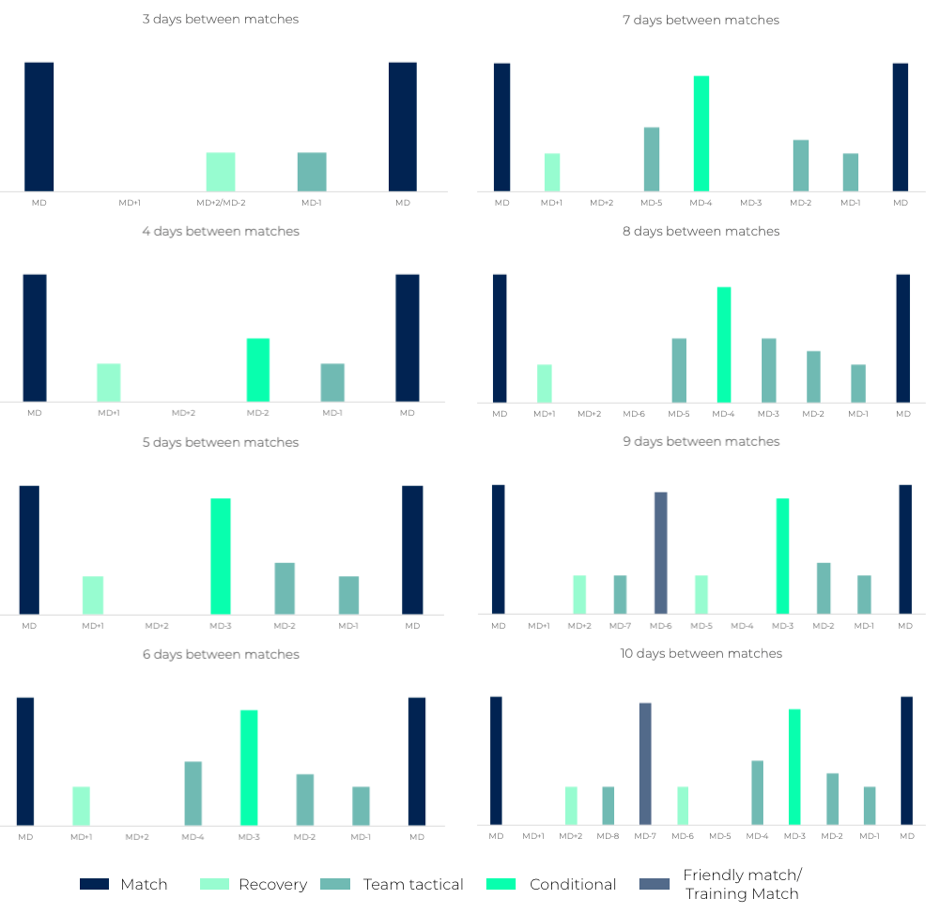Even though it is still common for amateur teams to play matches on a fixed day during the week, for professional teams we see more and more variation in the match schedules. Due to the coronavirus and commercial influences, we see that matches are not only played during the weekend (i.e. Fri-Sun), but they are spread over a broader period (i.e. Fri-Tue). This might lead to a team playing a match on Friday while the consecutive match is played on Tuesday the week thereafter (i.e. 10 days between matches). Or when a team plays on Tuesday, their next match might be planned on the next Friday (i.e. 2 days between the matches). The variation in these match schedules has important consequences for the training schedules. Hence in this blog, we will discuss the basic principles of a weekly periodization schedule, and we will give examples on how to distribute your training load over the week depending on the match schedule (ranging from 3-10 days between matches).
Supercompensation principle
There are 2 important principles to take into account for a weekly periodization schedule: supercompensation and variation. In short, supercompensation means that you physically challenge the body with the goal that the body will recover above the level as before the training (i.e. becoming fitter). One of the requirements for supercompensation to occur is that there needs to be 48/72h between consecutive physical stimuli. If the physical stimuli (i.e. conditional sessions and matches) are planned closer to each other, fatigue will most likely accumulate which might lead to a decline in performance in the long term. If the conditional sessions are planned further away from each other, supercompensation will most likely not occur: you will maintain the fitness levels of the players rather than improving them.
Principles of training variation
The principle of variation is linked to supercompensation. As we have discussed, the body needs to be able to recover to a higher level as before the physical stimulus. To enhance this recovery of the body, it is advised to alternate between higher load and lower load sessions during the week. This can be illustrated as a weekly training program that follows a wave-like pattern.
To apply these principles in a weekly schedule, a distinction between three types of training sessions can be made: recovery sessions, conditional sessions, and team-tactical sessions. As the model of tactical periodization already highlighted: when a conditional session is planned, this does not mean that the only focus is on the physical preparation of the players. Rather the goal is to incorporate exercises that help you build a team-tactical plan, while simultaneously targeting some physical aspects
Weekly periodization schedule
In figure 1, we have given some examples of how to distribute the load in different types of training weeks. It should be noted that these schedules are not completely fixed, and some changes might be made (i.e. corresponding to the wishes of the coach or to the specific situation). For example, the first two days after the match are focusing on recovery. Most often, the players are given a day off on one of those days. However, it is up to the wish of the coach whether he/she would like to plan this on MD+1 or MD+2.

Figure 1: Distribution of load over the week for different types of training weeks
Conditional session within your weekly periodization schedule
What can also be seen from the examples, is that the conditional session is planned on MD-3 or MD-4 (except for one case, which we will discuss later). Depending on the week, it might be better to plan it on MD-3 (shorter weeks) or MD-4 (longer weeks). But again, these are just guidelines. Based on your particular situation (e.g. extra days off), you might deviate from this ‘rule’ and plan a conditional session on MD-3 in a long week.
As already mentioned there is one case where the conditional session is not planned om MD-3 or MD-4. This is the week with 4 days in between matches. In this case, you plan an ‘underload conditional session’: you aim for the intensity of a physical session, but you limit the volume. Here is an example of how to apply this in practice: If you usually would like to play a 5v5 game 4 x 4 minutes, you would now choose to play the same game format (i.e. with the same rules, field dimensions, etc.) but you limit the number of repetitions (i.e. 2 x 4 minutes).
The last thing that should be noted is that in the longest weeks (i.e. 9 and 10 days between matches), a friendly match or a training match could be planned. Because you want your physical stimulus to come as close to a real match as you can, there isn’t a better way to do this than planning a friendly match or a training match (i.e. 9v9/11v11 possible with a reduced volume: e.g. 70min)! The week after this friendly match can then again be viewed as a 5/6 day training week, and the distribution of load will therefore also follow this pattern.
Conclusion
We see more and more variation in the match schedules at the professional level. This challenges trainers and coaches to design the optimal training schedule. In this blog we have discussed 2 training principles that need to be taken into account when designing a training schedule: supercompensation and variation. Furthermore, we have given examples of how to distribute training load over each type of training week. By applying the principles of supercompensation and variation to these examples, you can make changes to these examples so that they are in accordance with your specific situation!
